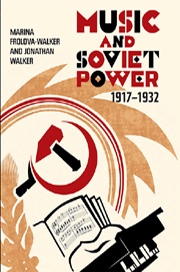Book contents
- Frontmatter
- Contents
- Preface
- Acknowledgements
- Note on transliteration
- Chronology of Political and Musical Events
- October 1917–18: Out of Chaos
- 1919: Depression and Fever
- 1920: Bureaucracy on the Rise
- 1921: Should I stay or should I go?
- 1922: Just Like the Old Days?
- 1923: The Birth of ASM and RAPM
- 1924: ASM in the Ascendant
- 1925: Equilibrium
- 1926: Guests from the West
- 1927: Celebrations
- 1928: At the Crossroads
- 1929: Velikiy perelom – The Great Turning Point
- 1930: RAPM's Glorious Year?
- 1931: RAPM's Fortunes Turning
- 1932: The Rules Change
- Key to Acronyms and Institutional Bodies
- Glossary of Names
- Bibliography
- Index
1925: Equilibrium
Published online by Cambridge University Press: 05 April 2013
- Frontmatter
- Contents
- Preface
- Acknowledgements
- Note on transliteration
- Chronology of Political and Musical Events
- October 1917–18: Out of Chaos
- 1919: Depression and Fever
- 1920: Bureaucracy on the Rise
- 1921: Should I stay or should I go?
- 1922: Just Like the Old Days?
- 1923: The Birth of ASM and RAPM
- 1924: ASM in the Ascendant
- 1925: Equilibrium
- 1926: Guests from the West
- 1927: Celebrations
- 1928: At the Crossroads
- 1929: Velikiy perelom – The Great Turning Point
- 1930: RAPM's Glorious Year?
- 1931: RAPM's Fortunes Turning
- 1932: The Rules Change
- Key to Acronyms and Institutional Bodies
- Glossary of Names
- Bibliography
- Index
Summary
1925 saw both the main trends in Soviet musical life gather momentum, but for the moment, they moved in their own separate spheres without serious conflict, even if this was unavoidable in the long run. One of the two trends was the cosmopolitan opening of Soviet musical culture to new European works and ideas, entailing visits by foreign performers and composers, performances of new Western music, and exploratory trips abroad by members of the Soviet intelligentsia. Here, ASM came to the fore, and its leading members now became known to a wide public. The other trend was the establishment of a self-consciously Soviet repertoire, the structuring of cultural life around the main dates of the revolutionary calendar, and a gradual dilution of Conservatoire elitism. Although RAPM is often considered the equal and opposite reaction to ASM, its role in the second trend was minimal at this point. RAPM had failed to secure any institutional support and after the demise of Musical Virgin Soil [Muzïkal'naya nov’], it was left without a press outlet. The situation was not the same across all the arts: notably, RAPP, which was RAPM's counterpart for writers, fared much better, acquiring a prominence that caused concern in the upper ranks of the Party. In February, after RAPP's inaugural congress, Bukharin spoke at a CC meeting devoted to literature in order to reinforce the arguments that Trotsky had previously championed: different literary groups and trends should be allowed to compete freely, and proletarian writers, accordingly, were not to be granted any special privileges.
- Type
- Chapter
- Information
- Music and Soviet Power, 1917–1932 , pp. 132 - 154Publisher: Boydell & BrewerPrint publication year: 2012



